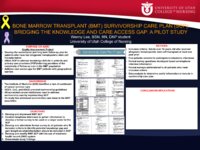The Graduate Nursing Project collection includes Doctor of Nursing Practice (DNP) Scholarly Projects and Master's students' non-thesis projects submitted as part of program requirements.
TO
1 - 25 of 5
| Title | Creator | Date | Description | Relation Is Part Of | ||
|---|---|---|---|---|---|---|
| 1 |
 |
Bone Marrow Transplant Survivorship Care Plan: Bridging the Knowledge and Care Access Gap: A Pilot Study | Lee, Wenny | 2018 | In 2006, the Institute of Medicine (IOM), now known as National Academy of Medicine (NAM), recognized that there is a lack of continuation of cancer survivor care in the United States. The IOM recommended that all comprehensive cancer centers address the need of survivor care by using survivorship c... | Graduate Nursing Project, Doctor of Nursing Practice, DNP |
| 2 |
 |
Bone Marrow Transplant (BMT) Survivorship Care Plan (SCP): Bridging the Knowledge and Care Access Gap: A Pilot Study | Lee, Wenny | 2017 | POSTER | Graduate Nursing Project, Doctor of Nursing Practice, DNP, Poster |
| 3 |
 |
Implementing a Dialectical Behavior Therapy (DBT) Graduate Group to Improve Knowledge of DBT Skills | Leggett, Sarah C. | 2019 | Problem. Patients with borderline personality disorder (BPD) struggle to strengthen and generalize coping skills after completing a 7-month dialectical behavior therapy (DBT) skills group. A formal process addressing how to increase knowledge of DBT skills after completing this group is lacking. Met... | Graduate Nursing Project, Doctor of Nursing Practice, DNP |
| 4 |
 |
Implementing Improved Mental Health Screenings in Home Health Care | Searle, Christopher B.; Whiteley, Kylie; Webb, Sara | 2023 | Background: Depression and anxiety are among the most diagnosed mental health disorders. Moreover, those with chronic medical conditions are more likely to develop mental illness and suicidal behaviors, which validated screening tools can detect. A high correlation between mental illness and chronic... | Graduate Nursing Project, Doctor of Nursing Practice, DNP, Psychiatric / Mental Health |
| 5 |
 |
Implementing Training Modules to Facilitate the Patient Health Questionnaire-2&9 (PHQ-2&9) Screening Administration for Improving Depression Screening in a Local Free Clinic | Nicol, Hanna | 2018 | Background: Major depressive disorder affects approximately 9 percent of the adult population annually and has a 17 percent lifetime prevalence in the United States (Maurer, 2012; Meyer & Grob, 2014; NIMH, 2015). Adult depression occurs more frequently in low income and uninsured populations in the ... | Graduate Nursing Project, Doctor of Nursing Practice, DNP |
1 - 25 of 5
